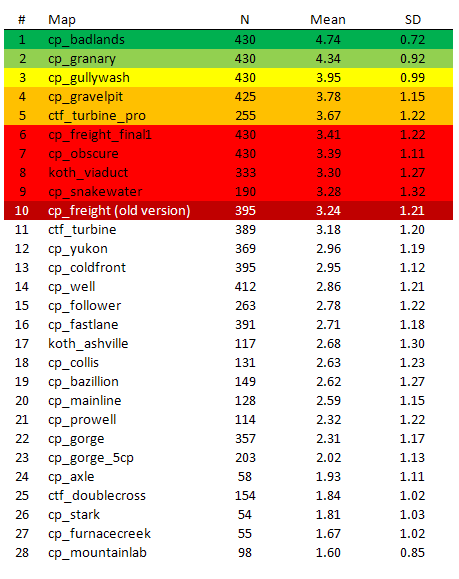Contents
0. Introduction
1. Layouts
2. 5cp Maps
2.1. Well
2.2. Fastlane
2.3. Prolane
2.4. Obscure
2.5. Yukon
2.6. Freight
2.7. Coldfront
2.8. 5Gorge
2.9. Follower
2.10. 5cp conclusion
3. Non-5cp game modes
3.1. Attack/defend
3.1.1. Gravel pit
3.1.2. Dustbowl
3.1.3. Gorge
3.2. CTF
3.2.1. Turbine
3.2.2. Turbine pro
3.2.3. Contest #4 maps
3.2.4. CTF conclusion
3.3. KotH
3.3.1. Viaduct
3.4. Other gamemodes
4. Final thoughts
0. Introduction
There seemed to be interest, so this is a follow-up to my previous article, here I want to expand on my previous analysis. The last article mainly covered the concepts for competitive maps, this time I will try to take a more practical approach, analyze failed maps, make suggestions for layout, and analyze examples of maps for non 5cp game modes.
If you have not read the old thread I suggest doing that, although it is not necessary. You can find it here:
http://forums.tf2maps.net/showthread.php?t=17141
1. Layouts
From the previous installment, I suggested that a proper layout is easy to learn and not overly complicated, gives different options for pushing and should not play too slow.
First off, let's start with some terminology, so you know what I am talking about. Entrances refers to the number of entrances to an area that are available. Just count every doorway or chokepoint leading into the area. Routes on the other hand are the attackers way of traveling into the area. If a route splits into two doorways, that basically lead into the same spot, I am going to count that as one route.
For example, going from mid to yard on Granary, there are basically 3 entrances into it, with the newly patched entrance, but essentialy only really 2 routes. If you count the routes a bit more towards 2nd, the route through ramp room splits into two routes, while the route to the right converges with one of the ramp room routes, counting left and right yard as one route each. There would be a total of 4 entrances though.

Entrances are green and routes are yellow on this Granary example. There are only really 2 routes to take here at any point, while technically having 4 entrances.
An important thing is the viability of a route, which relies on a couple of factors:
-Chokepoints on the route. Basically, the harder it is to get through the route when the enemies hold it or just spam it, the less viable a route is.
-travel distances and proximity to the control points.
-distance to/visibility of/overview over the other routes.
-availability of healthpacks on the route
I have seen a rule of thumb on this forum before, that a map should have 2 1/2 (2 main, and 1 side) routes from one area to the next. This rule works, but doesn't always hold true and you would have to bend it sometimes in order to fit it everywhere on the successful competitive maps. Additionaly, routes change in viability for certain situations. I have marked an example for it on Badlands, when one team has middle, and the other team is holding choke:
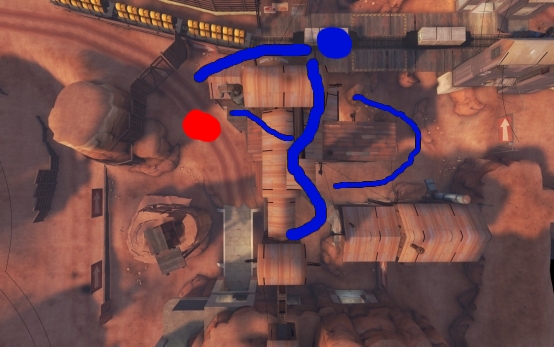
Attack routes for Blu
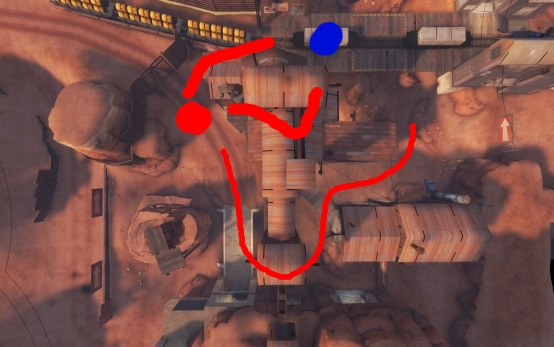
Attack routes for Red
In 5 cp maps, it is possible to have routes that lead around the 2nd control points, so you can bypass the point without seeing it. Badlands has that with the dropdown, Granary partially has it as well, although you always have to go trrough the room with the control point. Well has that mechanic too, but that's Well is a good example of how not to use it.
Another thing important to think about is the distance between certain entrances and routes from both sides. This mainly comes into play when comparing the distance the attackers have to travel to switch from one entrance or route to another versus the distance the defenders have to travel.
Dropdowns are a layout choice for a one way route, to give one side an additional route. It is possible to make dropdowns that can be jumped into again by certain classes. Scouts and sometimes soldiers will frequently use that on Badlands, or dropdowns that are pretty much one-way only, like on granary (although a soldier can jump up there and you will sometimes see a soldier try during matches and rarely see them succeed).
Long (narrow) tunnels or just long isolated routes should mostly be avoided. The connector from A to B on Gravel Pit is the only example I can think of, where the useage is acceptable. It is a minor route to give an additional option of faster travel between the two areas. Routes that twist too much are something to be avoided as well. You should not have many tight turns of more than 90 degrees in your map. The worst example are 180° U turns, which just break the flow of the map. Find a better way of connecting your areas and laying out routes.
2. Maps
Now that that is out of the way, let's take a look at some maps from competitive play on which I have at least some experience. I am writing this from a european point of view, I don't have much insight into the non-european communities. Furthermore, taste and opinion is a large factor here. Some of these maps are still quite popular and it depends a bit whom you ask, but I will try to make it clear when it is just my personal opinion, and keep the rest as observable facts.
Regarding this here are results from a survey done 4 months ago:
Players also like what they know, so this favors map that have been played more, as players have come to like the map for one reason or another (freight and obscure for example,were played in the ETF2L season 8).
2.1. 5cp
I'll start with the most played and most important game mode. There are a lot of maps to analyze here and I am focussing on those that have been played, but aren't played anymore.
2.1. Well
Let's start with probably the worst of the bunch, cp_well. I've played well pretty early in my competitive career, and it was in Season 7 of ETF2L. I actualy didn't really mind it back then, though I would not play it anymore now. Kind of illustrates how at higher levels of play, issues with the map are amplified. The most interesting thing about well is the setup time at the start of the round. This allows for every class to get to the point at the same time, and makes Heavy a viable class. At the same time it eliminates the need for a proper rollout, which is an important component of competitive play. Rulesets also have to be adjusted; if I remember correctly, jumping over the trains during setup was banned in ETF2L, you could however jump on them and spam over them. Not quite sure though. The setup time midfight doesn't really break the map, but in my eyes it's just a pointless novelty.
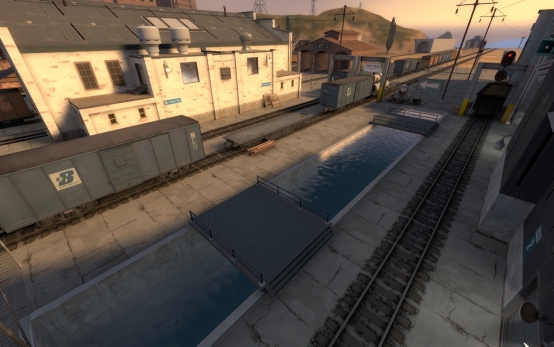
Everything converges here.
One glaring flaw of the map is the transition between second and middle. First off, I really dislike water as a game mechanic, but that's not the point here. When going from mid to 2nd, you are going through a no mans land. You only have one area that you can walk through, which is easily snipeable. From there on you only have two doors you can push through, which aren't that far apart, and the defenders have the same route back and forth as the attackers. On the whole way, there is no health and no ammo, which makes pushing through there all the more annoying. This means it's not easy to get into the second point.
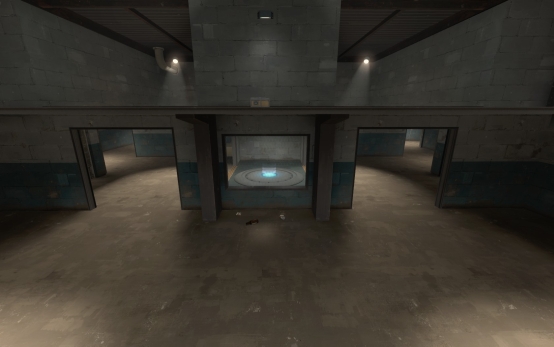
The second point itself is another part. First of, the whole building, except for the room with last in it, pretty much only consists out of tight hallways. This is not only incredibly annoying for scout players, as their options are quite limited. It also leaves less room for more advanced and refined pushes. The only option is pretty much to get uber and then to push with it. Above second, there is a unnecessarily large and complex area. Players can only get there after they entered the building through the two main doors, and the way around is quite long. Furthermore, players cannot do that much from the top, especially considering the length of the way up there. The resupply next to 2nd is a bad idea too. Defending players can just stand in there, deal damage, get full life and ammo instantly and deal more damage, while being safe from pretty much anything. The resupply works on Badlands, because it is quite disonnected from the actual control point, and therefor makes that area feasible to hold.
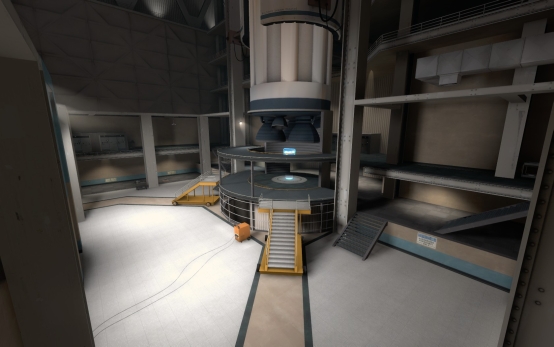
On the last point, the two major options that lead to it will leave the attackers at a significant height disadvantage. To run all the way around and push from top takes quite some time. I am not sure about the balance of it, but pushing last is not enjoyable in my eyes.
Another thing is that the map is quite flat. The main push routes are the same height level throughout the map, and the most variation in height is in the tight indoors second and on last. One minor thing, with the middle point being inside a building, the roof beams and cables are annoying for a soldier trying to rocket jump. I also have an aversion against randomness in a competitive environment, so the trains are pissing me off as well.
What can we learn from it?
-The layout should not be overly simple at one point, where all the routes converge and way too complicated right past that point. It doesn't even it out, it creates a bad map.
-2 doors, pretty much next to each other, as the only push routes are a bad idea
-Really tight indoor second points are bad, since they limit the options for both teams. With a last point this can work, since there can be more routes into it. Adding more routes on a second point would make the layout too confusing.
-cater to every class, well fails to cater to scouts and partially soldiers
-avoid a resupply too close to the control point
2.2. Fastlane
Fastlane is another failure for competitive play. First of all, there are significant sniper sightline issues on the map. On mid, a sniper can just stand on the wood walkway to the left, and he has complete overview over middle. On 2nd, a sniper can just stand behind the point on the walkway, and again has complete overview. At the same time on both spots, the sniper is at both spots quite hard to pressure, and you would have to go through the enemy team to get to him.
[picture of each spot]
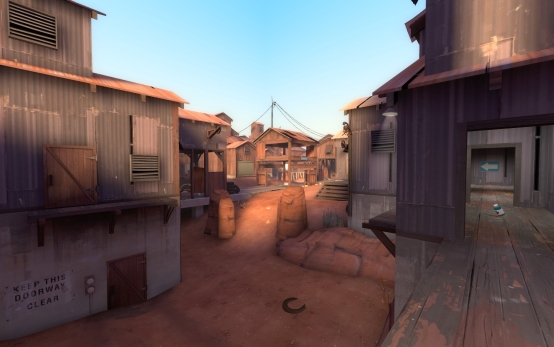
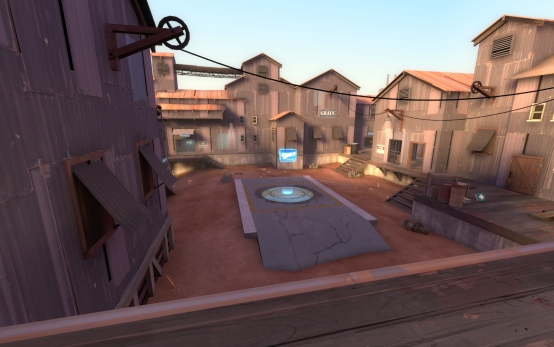
Way overpowered sniper spots
It's not a problem when snipers are viable on a map. It is a problem when there is literally no way of avoiding the sniper when pushing. You have to be able to either pressure the sniper, to flank him or to avoid him. Or at the very least be able to spam him, those walkways make that harder as well.
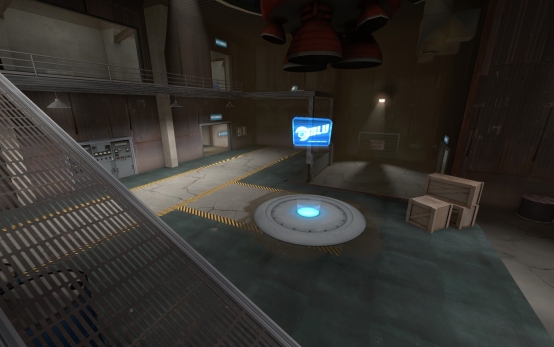
The next flaw of Fastlane is the almost impossible to push last point. Let's break down why it is so hard to attack that point:
-Out of the 3 entrances into the point, 2 of them have a rather harsh height disadvantage, making it hard to push through them.
-The 3rd entrance is a long corridor, where the attackers can get their uber forced pretty early, without much possiblity to do anything from there. This means there is no really feasible entrance for getting in.
-The point itself is on low ground and completely exposed in the middle of the room. Getting onto the point makes the attackers quite vulnerable, and due to the size of the capzone, it is relatively easy to block. This forces the attackers to pretty much wipe the enemy team before being able to cap the point
-In addition to that, the spawn doors are close to the point and you can it from their safety. Respawning defenders (or just defenders that went for the resupply) will also have an easy time getting back into the fight.
-Having the easy overview over the whole room favors the defenders. There is no threat of a scout sneaking in onto the point, no threat of someone on a high ground
The actual control points are also all flat. There is some height difference, but not that much that comes into play, except for the last point. I read some hate on copying Badlands spire in 5cp maps. While it is obviously a no go to use the spire prop, I made a Badlands inspired (hoho) tower on my map as 2nd point in order to promote interesting vertical combat. Seriously, if someone think flat points like that are a better idea than applying own concepts to the spire idea, I'm going to slap him.
Lastly, there is a lot of health on the map, mainly there are a lot of medium healthpacks available. It doesn't do much good for the map, but it's not really a factor that breaks it either (it's broken without them too).
What can we learn from it?
-Snipers must not be too strong. If a sniper is that dominant on a map, it ruins it for every other class.
-The last point has to be attackable. Open areas close to spawn that are hard to get into help the attackers too much. It works on Granary due to a couple of factors. It is way easier to get into the area through those sideways door, that lead into the opposite way. The attackers can switch from one door to the other quicker than the defenders. On Fastlane, this is the opposite. Both bottom entrances face each other, and the attackers would have to go the long way around to switch from one to the other, while the defenders don't even have to move. Furthermore, the way back into spawn on Granary is longer and leads through that extra room.
-Large open areas and a lot of healthpacks on a map do not make for a interesting/fast paced map.
2.3. Prolane
Prolane is an attempt to fix the issues existing in Fastlane, in order to make it play better in 6vs6. I don't have much playtime on it, I played it once or twice and that was a while ago. I can't tell that much about how some of the changes play, but some old issues still exist, while new ones came up.
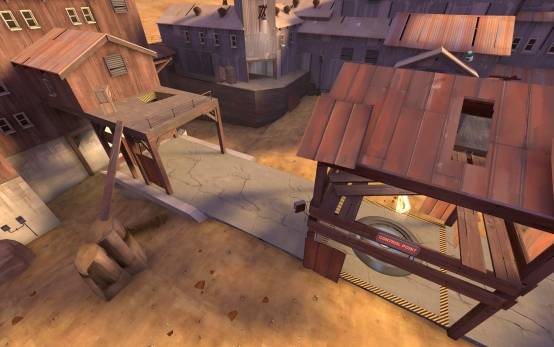
It heavily nerfs snipers on mid, but they are still as strong on second as they were before. Furthermore, it adds quite some routes at 2nd and last, in an attempt to make last easier to attack. Last is easier to attack in this version, but the connection between 2nd and last is now a huge mess with way too many routes everywhere and little overview over the area. Pushing out of last was hard on the original map, but now it is pretty much impossible, as a whole team will be able to sneak around you on these routes.
What can we learn from it:
-If you try to fix something, you might break something else. A map with as many hard problems as Fastlane can't be that easily fixed, without a major redesign. Just adding a bunch of routes won't do the map good.
2.4. Obscure
Obscure is a very interesting example to analyze. It was designed with competitive play in mind, even more so as a fast paced map, by Byte, a player with top level experience nontheless. (ETF2L thread for reference). It was also tested a lot and adjusted accordingly, so it was supposed to be good.
It turns out it is one of the slowest maps played in competitive TF2, at both high and low level play. Pretty much every point is hard to attack and rounds often last 15+ minutes. On other maps, these long rounds are often quite fun with a lot of back and forth. On Obscure they are a common occurence and are quite taxing, when every other push fails. Additionaly it your team needs uber for pretty much every push. So let's take a look at the individual points.
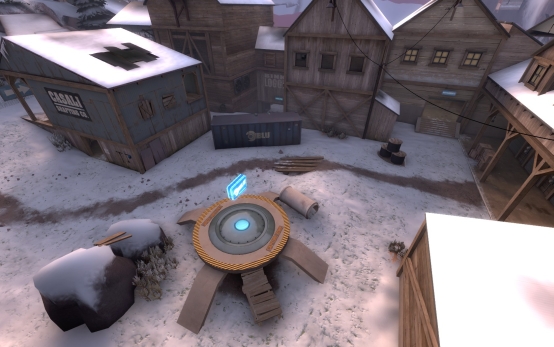
The chokes between mid and 2nd make either point hard to push. Looking at the right one (looking from 2nd to mid), you are pretty exposed when trying to make your way through it. Once you go in through it, it is pretty hard to back out again. Same thing with the middle entrance, you are at a height disadvantage while going through there and it's hard to get through, and once you are in, you are committed. The far left entrance is a bit covered, so it is easier to get in, but going around that house your team is far away from the actual points and has a lot of distance to cover, and it is pretty hard to back out again.
In addition to the chokepoints, the area is quite large and the actual point is quite far back. This means getting on the point to forcing the defenders to act is not possible, you have to get to them and win the fight in order to cap. The open area also means that snipers are a large threat. Snipers are very strong on the map as a whole, too strong for my liking, but not totally overpowered like on Fastlane.
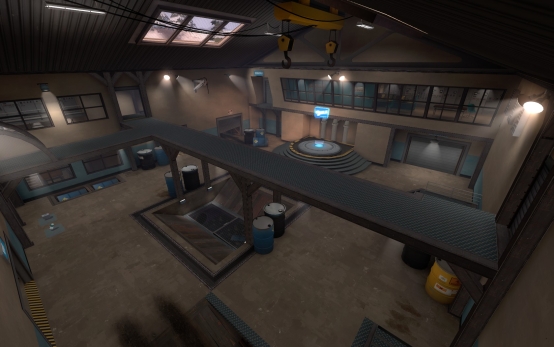
Last is also quite hard to attack. First of all, the room containing the point is quite open, similar to Fastlane. Unlike Fastlane, there are more entrances, but every entrance is quite small (except the bottom one, which is at a height disadvantage) and very easy to spam, which means it is hard for the attackers to get into the fight (which is similar to Fastlane ). The point itself is hard to reach in the room and quite exposed from the top, so the sneaking in and just capping it quickly doesn't work either.
). The point itself is hard to reach in the room and quite exposed from the top, so the sneaking in and just capping it quickly doesn't work either.
Many people still like obscure, if you take a look at the poll results. It would a fun map if it wouldn't play so slow. There was a redesign announced to be played in Season 9 of ETF2L, but as of the time of writing this, it's release is scheduled in Valve time.
What can we learn from it?
-Having top level experience in TF2 when designing it and even testing it a lot in pickups does not prevent your map from having flaws. One thing to note here is that a map requires a learning process in players and teams as well. When being played for the first time every map will play way more chaotic than it will when players and teams have learned the map. Don't confuse that effect as the map playing in a certain way. Players have to learn the map and that changes how the map is played a lot. This is what makes it so hard to predict how a map will play.
-It does have some similar issues like Fastlane has, after all they are both pretty open maps with a hard to attack last. Try to avoid making the same mistakes
2.5. Yukon
Yukon is a bit of a love and hate map from what I have experienced. Either people love it or they hate it. There are a couple of issues existing in the map, which I want to cover here. I mainly played the older version with the middle point below the bridge, but playing the newer version once, it did still have similar issues.
Again with the sightlines. Snipers are strong on this map and there is not that much cover from them.
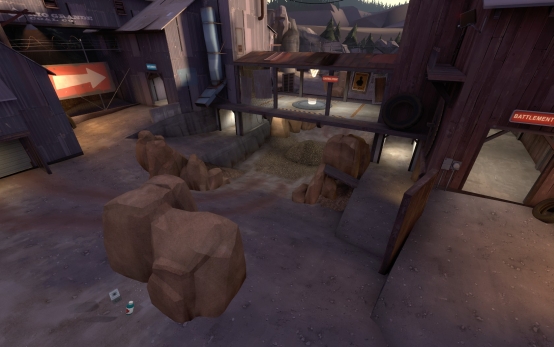
The updated middle, I don't have a screenshot of the old one
The area of mid is really large and there is little incentive to actualy push onto the other side. If you started capping the old point on lower ground, you would just get killed against the height advantage. Pushing through the narrow halways on either side will just get you spammed to death too, so it's best to just sit on either side and spam the enemies. Soldiers can jump onto the top of the Bridge, but the distance to the enemies is too large to really make use of that. Stepping on the point too early can also be dangerous on Granary for example, but unlike on Yukon, there is no place where the team can just stand and spam all day long. When there is a spamfight on Badlands it will end too, since the teams will be much closer to each other and there are way more potent flanking routes than on Yukon.
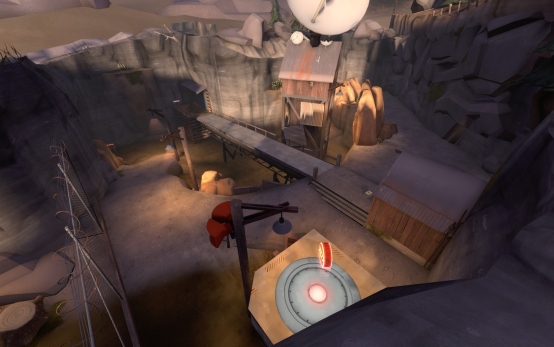
Yukons last point is also hard and rather annoying to attack. Either way you push, you have to cover quite some distance to the point, while not having much maneuvarability. In addition to that, you are either at a height disadvantage, have to run on a narrow pipe, or have to push through a long corridor.
What can we learn from it?
-The design for the middle point can't promote staying defensive too much. There are several factors for this. Sizes of the areas on each side of the point, distances from the point to somewhere else, where are height advantages?
2.6. Freight
Referring to the poll results, Freight is the most popular out of the maps I am analyzing here. There were a couple of changes in different Freight versions, and I will be focussing on final1 here, since I played that so much, that I can't remember all the differences. My complaints should be pretty much identical for both versions anyway.
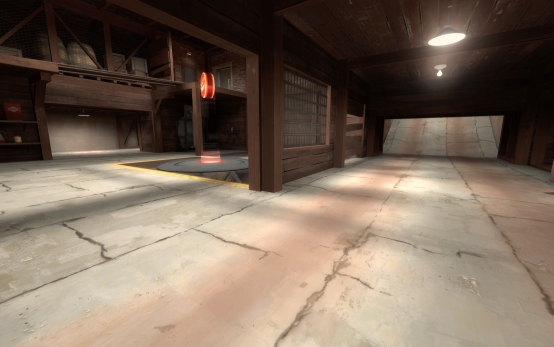
In Freight, we find something that is present in Well. The close quarter 2nd point is one of the main issues with the map. The 2 doors leading from mid to 2nd are directly next to each other on both maps (including the water exit), but have some differences. The attackers can switch from door to door pretty easily, while the defenders have to go the long way around. Furthermore the attackers have a height advantage right at those doors. The tight inside doesn't give the teams many options and results in boring gameplay.
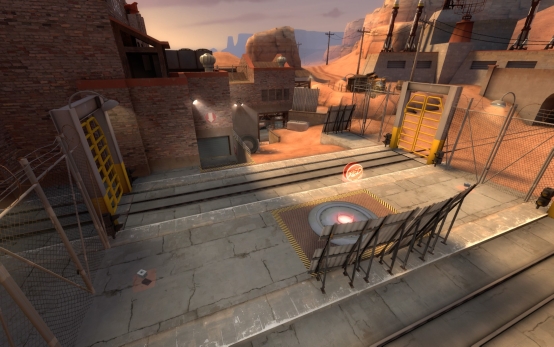
Another point is the hard to attack last. The issues here are similar as the previously analyzed hard to attack points. It is hard to get into the fight, either you have to go through the door to the left (defender pov) which is really easy to spam and hard to get through, or you have to go up the bottom or from the top left, both of which easy to spam and the attackers have a lot of distance to cover. To make it even harder, like with the other hard to attack last points, the attackers have to pretty much wipe out the enemy team.
One thing I would change on the map are the random trains. The trains can make last harder to push, when they cut the attacking team in half. Most of the time the trains are rather annoying anyway. And especially for a competitive map, I would rather see a system where the trains aren't random, maybe tight to captures, maybe triggerable by the players, maybe at fixed time.
What can we learn from it?
-Again like on Well, the close quarter second point is not a good idea. Granarys indoor second in comparison is much shorter, but wider, making it more interesting and making it actualy work.
-Last is too hard to attack again.
2.7. Coldfront
Coldfront is according to the poll results not very liked. There is cp_warmfront which fixes some of the complaints, but it wasn't included in the poll. If I remember it correctly, some major complaints come from having low framerates on the map, but that is not the focus of this article, so let's find some other flaws.
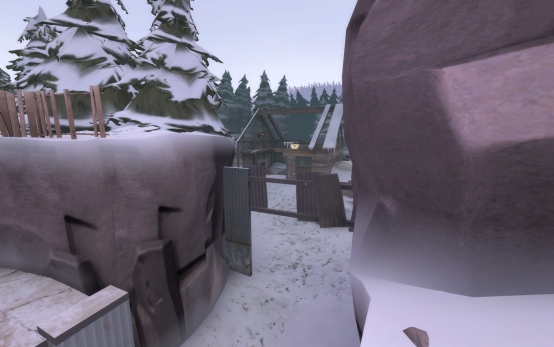
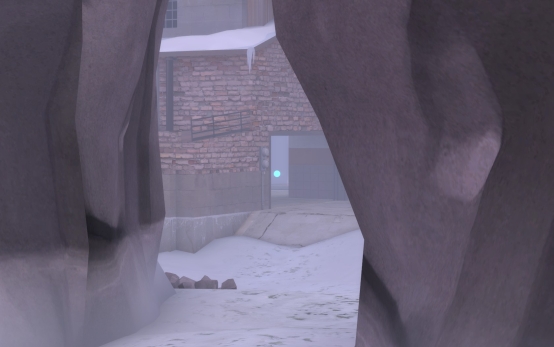
A certain Australian class enjoys these
Take a look at what the sniper sees from here, while being in a quite safe spot. There are more of these long sightlines across the whole map. When approaching 2nd, on 2nd itself, on last and on mid. This is pretty much the same complaint like on Fastlane.
As for me I find the map quite boring to play on. None of the points is really interesting. The house in the middle is awful for jumping on and using it's height advantage in actual gameplay. From 2nd to last it is inside, and while it is open enough to allow for some jumping at least, 2nd is just flat and boring. Last is ok I guess, nothing specian and you have to be really selective where you stand because of sniper sightlines.
What can we learn from it?
-Optimize your map, comp players don't want any framedrops. This is not really an issue with the snow theme, but more a general point.
-Can't stress enough how important it is for 6vs6 to not make snipers too strong.
-Make your map interesting. Even if that means borrowing a concept from an existing map, an uninspired flat point in an open area is worse.
-Snipers are quite strong on mid, but it's ok in my eyes, since they aren't very useful on 2nd.
2.8. 5gorge
This one should not need a lot of explaining. Gorge was designed as an attack/defend map, which makes a bad idea for a 5cp map. We will get to Gorge later in the A/D maps section. That there is only one way of walking from middle to 2nd should be enough to dismiss the map. Even with that it is quite wide, there is a lot of stuff (routes/rooms/hiding places) between the control points and it is just too much for a 5cp map. The routes are made for pushes into one direction and holding from the other side, no real position to hold last from, middle is quite dull, the death pit below mid is still a death pit, snipers are too viable for a 5cp map, too much health/ammo on the map, it's just not made as a 5 cp map. It would need significant changes to be viable.

What do we learn from it?
-cp_5gravel and cp_5fort would be a bad idea too. Although with the amount of 2fort modifications and remakes, 5fort probably already exists. Most designs just don't fit easily into another game mode, especially when they aren't that good for their original game mode as well, but more on that later.
2.9. Follower
Follower isn't really played in Europe. Wireplay had it in their league, I think I only played it once or so.
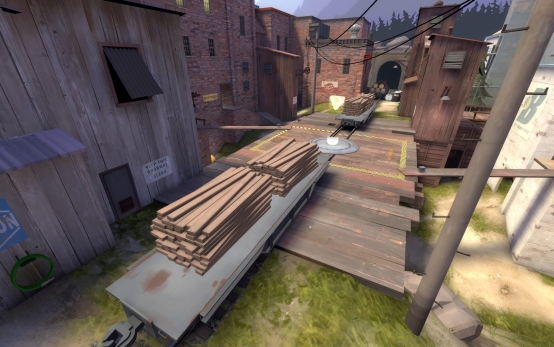
Where have I seent his before?
While I have nothing against taking established concepts and trying to execute them well, the Follower points just take a bit too much from their original counterparts in Granary and Badlands. There was something about Follower that just made me want to play the originals. Some people really like it, but it's unlikely that it's going to be played here. I don't really have much more to say on this map, I guess it plays well, but I don't know really.
What can we learn from it?
-Be more creative. My map borrows quite some ideas from badlands, but I tried making it different enough and tried to apply my own ideas to the general concepts found in Badlands.
2.10. 5 cp conclusion
5cp maps have many different qualities and a lot can go wrong when designing them. Too hard to attack last points and too strong sniper sightlines are very common issues, so you have to watch out for those specifically. Very tight and limiting areas are another large threat to competitive maps. At the same time they should be different enough from existing maps to make playing them interesting.
As the most played game mode, you will have an easier time of getting people to test your map, which is necessary for it to be successful. You will at the same time have more competing maps.
To sum up the specific qualities needed for a 5cp map:
-Easy enough pushes. I have never heard a single complaint in the competitive community about any point being too easy to attack.
-Diverse, fast midfight
-Challenging but rewarding rollout
And a reminder, here are the more general points from the last article:
-balance between the classes
-easy to learn layout with enough depth for tactical variety
-a proper learning curve
-good optimization
I think that just about sums it up. I could add some more maps, but I don't have much eperience on them. I thought about doing Gullywash, but the only thing wrong with it was the quite turtleable last point and that got fixed in the pro version (similar with Snakewater). I also considered covering bazillion, but I wouldn't really be able to stay objective at all, since I associate bad admin decisions with that map, but I don't like it anyway . For every other map, I and the people I have spoken to while writing this, don't have much if any experience on them. Collis was the most likely candidate, but I can't say much about it at this stage, so I left it out.
. For every other map, I and the people I have spoken to while writing this, don't have much if any experience on them. Collis was the most likely candidate, but I can't say much about it at this stage, so I left it out.
3. Non-5cp game modes
Now with 5cp maps out of the way, there are Attack/Defend, CTF and KotH maps, which are being played in competitive TF2. I'll go ahead and analyze relevant maps for those game modes, and will give advice what maps for these game modes need.
3.1. Attack/Defend maps
Let's take a look at attack/defend maps first. In my eyes, the stopwatch game mode makes for some of the most exciting moments and is one of the most fun things to spectace. Players are often hesitant to play Gravel pit in mixes and even as a team though, because it requires more coordinated teamplay and is not as easy to just wing it like on 5 cp maps.
3.1.1. Gravel pit
Gravel pit is one of the two maps from release still being played in competitive play, and according to the posted poll results reaches third place in popularity. If you take a look at the article linked with that poll, the map is more popular for higher divisions. This can be explained with the required teamplay as well.
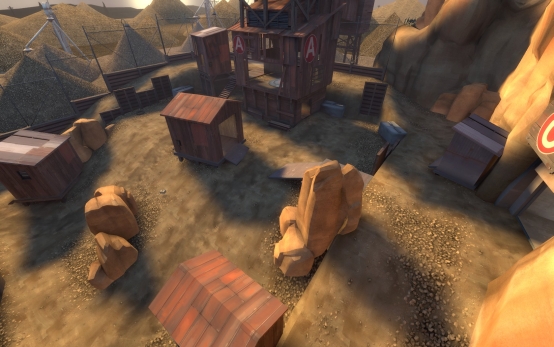
Starting with the 3 points layout, Gravel pit gives a lot of options to the attackers, something the linear maps don't do. This is not limited to either attack A or B first, but influences how the points are attacked. Most of the time you will see the defenders holding B and the attackers capping A first, although there are different tactics. The two attackable points mean that the attacking team is pretty much guaranteed to cap one point, which is required for the stopwatch mode to function (an easy enough to attack first point does that just as well though of course).
The actual areas on the map are quite large combat arenas. Snipers are quite potent on the map, but not overpowered. A defending sniper is strong at getting picks, but pretty useless once the attackers get into the actual fight, and will just die then. From an attacking sniper there is enough cover, or the sniper has to go in far enough that he is easily pressurable and gets picked there. There are long sightlines, but there are also a lot of routes and it is generally pretty easy to get into areas compared to the usual 5cp maps.
With 30 seconds in the editor, A and B cap quite slowly. This makes them mostly into deathmatch arenas, where you have to kill the enemies before capping, since capping during the fight is not really an option. The amount of routes into each area is one thing that makes the points easy to attack though, at least when the attackers are coordinated. On Gravel pit it is generally a large theme to draw the defenders attention to one side in order to attack them from the other side and pinch them in from both sides. I marked them for you:
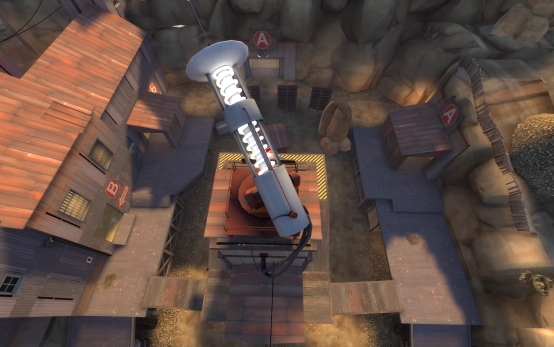
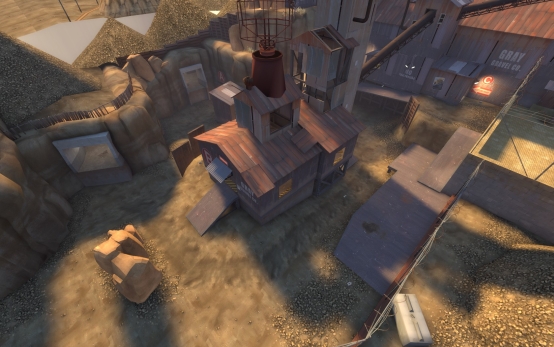
Focus: entrances
As you can see, there are not only many and quite wide entrances, the entrances are also spread apart and lead into the area from vastly different angles (180° radius for both shown points).
The large areas with a lot of geometry make for nice combat and offer every class something to do. The size and amount of stuff to jump on and run around gives scouts nice options, the vertical space gives the soldiers and demomen something to jump, there are still chokepoints and places for a demoman to put sticky traps and as already mentioned, snipers have sightlines, but are not too strong.
3.1.2. Dustbowl
In contrast to Gravel pit stands the other Attack/Defend map from release, Dustbowl. Dustbowl has none of the qualities of Gravel pit. All areas are much tighter and way easier to spam. The map is really linear, leaving both teams with much less decisions to make and making the map a whole lot less dynamic. Adding on to that, the layout is completely linear and there are way less routes leading into each point.
Dustbowl matches can go on forever on the impossible to attack 3rd stage, or they can be over rather quick when it is a steamroll. I think there is a Dustbowl pro, which removes the last stage, but that doesn't make the first two stages better.map
3.1.3. Gorge
Gorge presents a bit of a middle ground between Dustbowl and Gravel Pit. It is very wide with quite some interesting geometry to use. At the same time it has a linear layout and therefor only one push direction. The entrances into an area, while being quite far apart, are still all on the same side of each area.
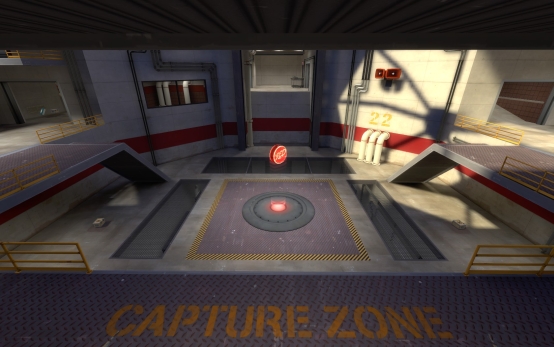
Some of the major criticism of Gorge comes from the painfully hard to attack 2nd point. With the geometry of it, this should not be a suprise actualy. It is way too easy to block, the attackers are way too exposed from everywhere while capping and the defenders are way too safe on their high ground near spawn.
The strength of snipers on the map is also an issue. There are some sniper spots (for example the high ground in front of 2nd spawn) where the attackers are exposed to him way too much without being able to put any pressure on him.
3.1.4. A/D conclusion
If you want to make an attack/defend map that is viable for competitive play, you need to learn from Gravel pit and why the other maps are not Gravel pit. At the same time, you must not make a Gravel pit clone. This presents a huge challenge, I tried comming up with a layout that is distinct from Gravel pit and still gives the attackers and defenders a good deal of possibilities, but had a hard time doing so.
Even with such a layout, it will be way harder to get the map tested and to adjust it accordingly compared to making a 5cp map. It can be challenging enough to find a Gravel pit practice game and it can be hard to get people to test new maps. To test an attack/defend map will be twice the challenge.
You have to approach A/D differently than 5cp. The amount of routes and entrances into an area, the sightlines you can have, the amount of items on the map all need a different approach than 5cp maps.
I would suggest not to use a linear layout, but making a 3 point gpit style layout will highly likely make the map too similar to Gravel pit. The layout should at the same time not be too complicated. Another suggestion I have is to make the rounds more streamlined. With that I mean giving the map a fixed timer, in which the attackers have to cap as much as possible as fast as possible. With something like 40 second setup and 7 minute attack times, a stopwatch round would take 15 minutes at most. This keeps an entire best of 3 at 45 minutes at the very most. Gravel pit can feature significantly longer games. Those are quite rare, but when they happen are really annoying for scheduling games properly.
3.2. CTF maps
To be honest I don't really know what to write here. There has been the contest #4 on here in order to create competitive ctf maps. Apart from them being used in wireplays 7vs7 league, I have never played any of those in 6vs6, nor do I have heard them of being played in any league. The map that is being played was mainly turbine and now it's update of turbine_pro.
While there is not much room for different rulesets in the other game types, ctf maps are heavily influenced by the used ruleset. 30 minutes was boring beyond belief and was abandoned from the leagues (it also led to steamrolls never ending, making results like 28 to 2 possible). The current rulesets are 30 minute timelimit, 5 caps wins a round, 2 rounds win the map (ETF2L) and best of 3 with timelimit 10, caplimit 5 (ESL). The ETF2L ruleset has the problem of one team keeping the flag at their spawn (discussion about that). I think NA leagues play two halves of 20 minutes, team with the most caps total wins; I never played that.
3.2.1. Turbine
So let's get into analyzing the only map that I can really analyze here. Turbine features an intelligence room that players can get to without going past the enemy spawn. This is an absolute requirement for a competitively viable ctf map.
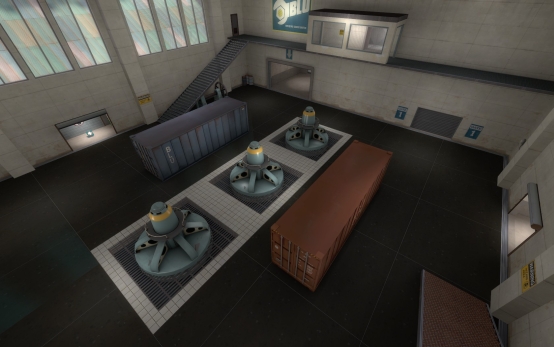
The deathmatch arena that is the middle of Turbine is part of its success. It's large enough for 2 teams to have a fight, has vertical space to use and is not unnecessarily big for the purpose.
Some problems arise on Turbine. The map can play a bit stale when having to push the Intel room through pretty much the same entrance every time. There is only really one main route to push in there and the defenders can often quite comfortable camp the intel. At the same time this creates a push/hold dynamic between center and intel, where it is a bit like a 5cp map, just that a succesful push gives you the intel instead of another point. On the other hand, if one team gets a proper sentry set up at mid, it can get really hard to push out again.
3.2.2. Turbine pro
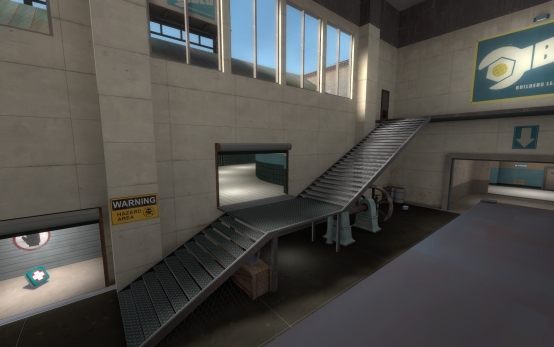
The new entrance on mid
Turbine pro tries to fix the major complaints with turbine and make it a more interesting more dynamic map. There is a small ammopack on middle, the absence of which was mainly a huge annoyance than anything else. The vents are also a bit wider, and there is a ledge over the intel in the intel room now, giving more strength to the vent entrance.
The main change however is the introduction of a new route from middle into the tunnel leading to the intel. This new entrance gives an additional opportunity for pushing, which increases the pace and improves the map in my opinion/from my experience.
Turbine has a pretty straight forward layout, so I think I said everything I can say about it. Depending on the ruleset the map can be quite exploitable (see the thread linked in 2.3.), but that can happen on any ctf map with the wrong ruleset. Turtling the intel/mid can still be an issue on Turbine pro and can make the map quite boring.
3.2.3. Contest #4 maps
The 3 maps I have played from the contest are Cloudburst, Wildfire and Converge, and that was only in the less serious 7vs7 game mode. So I cannot tell much about how they would actualy play 6vs6 other than theory fortressing a bit, but let's just take a look.
Starting with Converge, the invade game mode is quite experimental and it will be already just as hard as on A/D maps to get proper tests for ctf maps going. However, it could be a fix to the turtling problem that is inherit with the game mode. It has been some time since I played these maps, but if I remember correctly, converge was too large and too corridorish past the middle. This was the best out of the 3 in my eyes. While it seemed quite easy to turtle, during a coordinated push (not how we played 7vs7 ) it should be reasonably easy for a scout to sneak the intel in or soldier to jump in.
) it should be reasonably easy for a scout to sneak the intel in or soldier to jump in.
Cloudburst might be promising too, although there aren't enough routes on the map. While on Turbine all the routes converge at the center too, the center of Turbine is more open and makes for a more interesting place for combat in my eyes. The problem with the routes on Cloudburst is that they are too close to each other and aren't very distinct. This makes for more stale gameplay. Furthermore, the intel is tucked away in a boring house.
Wildfire, which won the competition, isn't that good in my eyes. There is no place to really have a fight on the map, there just doesn't seem to be enough space for that since the map is too tight in the middle. The intel rooms are fine, but there is not enough overview and not enough space in the middle.
Maybe some of the other maps from the contest would be suitable, but I haven't looked that much into them in order to bring up one.
3.2.4. CTF conclusion
The ctf mode is on the one hand promising, but on the other hand comes with a lot of inherent problems. When the intel room can be turtled, then it will be problem, just like a too hard to attack last point. Trying to break a defense a couple of times is as fun as literally running into a brick wall.
I tried comming up with some concepts for ctf maps, but they would be too similar to Turbine, so I made a 5cp map instead .
.
What it comes down to, is that competitive CTF maps need the push/hold dynamic, similar to how 5 cp maps play, in order to be succesful. This means you need areas you can hold with your team, which give you control of the map, or control of your intelligence. It works on Turbine and that's why Turbine is the go to CTF map in competitive play.
3.3. KotH maps
The final gamemode relevant for competitive play is King of the Hill. KotH maps aren't very popular in Europe, so I don't have much experience on them, but I will try my best again with what I have.
KotH is probably the fastest game mode, with one team always being forced to attack by a ticking timelimit. Teams have to make quick decisions and the roles usualy change multiple times per round.
The point is the obvious center of the map around which the gameplay should revolve. Nucleus is guilty of not following that. While the point is in the middle of the map, the point doesn't really come into play that much. The map has many other flaws, for example a sniper can clear the point while standing just out of spawn, definately not a good idea.
I would try to cover Ashville, but I don't know much about it and no one I talked to really could tell me much either, since KotH isn't played in Europe anyway. I played it once and really liked it then, but that's about it.
3.3.1. Viaduct
Viaducts position can partially be explained by it was here first in my eyes. I find it to be a good map, but not great. There is Viaduct pro which is gaining some popularity in Europe, but I haven't played it yet, so I won't comment much on it, but I have heard pretty much only good things about it.
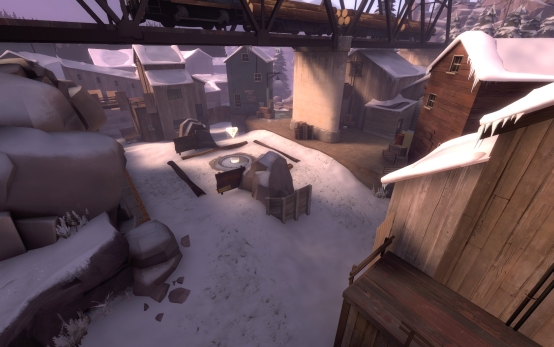
Let's start with what is bad. There are complaints about framerates, but these aren't of much interest here. Gameplay wise, snipers are really strong on the map. Similar to the issues on 5 cp maps, a spot where a sniper has a good overview of the point while being in relative safety is not a good idea. The funnel that is the middle of the map makes it hard to get past the enemy team to kill the sniper, the high up position and the boards as cover make it hard to spam him. Another take on the general sniper problem could be: If the best option of dealing with the enemy sniper is to run one of your own, the map is too sniper friendly. There are also complaints about heavies being too strong on the map. Heavies are strong where mobility is not needed that much and with the funnel at the point, the Heavy can just lock down any aggressive move from the enemies, while the sniper picks the enemy team apart.
The point in Viaduct is on a small hill, pushing onto it gives you a small height advantage over other parts of the map. At the same time, the point is a bit exposed from different routes into it, making it attackable. You can push past the point and take the enemy cliff for example, but the map is very wide at that point, so the attacking team can get in on the other side, so you need to cover that too. Pushing past that and kind of camping the enemy spawn is not really feasible, since the attacking team has a spawn time advantage and you won't get much time out of that.
Viaduct pro adds a route past the point (not on the cliff side), which allows more freedom to sneak by, run past a heavy, flank the sniper etc. It also makes some adjustments to nerf the sniper and increase framerates. It removes the snow theme too, color blind players can have problems telling the teams apart on them.
3.3.2. KotH conclusion
When thinking about KotH maps, I always have that feeling that trying to push the same point for 30 minutes can get really stale and boring. When actualy playing them, this isn't much of a problem. Teams do however need less tactics, due to there simply being fewer areas and only a single control point to push, compared to a 5cp map.
For a competitive KotH map, it needs some of the qualities of a 5cp map, minus 4 of the points. It needs a proper push/hold dynamic, which Ashville and Viaduct can provide, while maps like Nucleus or Sawmill fail to do so. It needs something like a rollout as well. From the maps that work, making the area of the point narrower, and the area between spawn and the point wider seems to work.
3.4. Other game modes
This section will mostly be a brainstorm with some ideas that I have/had, that you may find interesting. First of all, what about the existing map types that aren't played competitively.
A is for arena. I wasn't into competitive TF2 when the arena game mode came out. I think there has been some experimentation with it in the competitive community, with different formats for it (3vs3, no medic/engie) but ultimatively it never went anywhere.
B is for bear, or payload. There never has been a lot of interest for payload for 6vs6. Payload maps are pretty much a staple for Highlander though. The main maps to take a look at here would be Badwater and Upwater, which are more open and less spammy than Hoodoo or Goldrush are. I think single stage maps are better for competitive play anyway. They play faster and it is easier to keep track of the time. I am not really into Highlander, so you better ask someone else .
.
Payload race might have some potential for competitive play, but multi-stage payload race is a failed concept. When a team can win 2 stages and then lose on the third, why would there be the first two stages? That failed design pissed me off on public play on pipeline and makes it not viable for competitive play. I haven't seen or thought of a payload race map concept that would work for 6vs6. Having a map that partially forces a team to split up and do 2 different things is not a good idea, when teams only have 6 players on them, so this gives quite some challenge to someone who would map for that.
Territory control. The gamemode is something that might work, a map like Hydro doesn't. The assymetrical design and randomly chosen areas pretty much eliminate any chance the map might have in a competitive environment. The map would have to find a solution to stalemates, by one team winning one part and the other team winning another part back and forth. I wouldn't really recommend trying to make a competitive map, given the high effort of making a TC map and the difficulties in making a map competitively viable. Making the individual stages KotH might be worth a consideration..
The thought of TC with KotH stages brings me to another idea, multi-stage KotH. I don't know if this is even possible from a technical point right now though. With KotH maps being played best of 5, there could be a KotH map with multiple stages, that are cycled through as the teams win. These could be 5 distinct stages, or just 3 stages, which repeat if the match gets that far.
There can also be different concepts for push maps. Instead of 5 cps, how would a 3 cp map play? A 3 cp map should, in theory, be higher scoring than it's 5 cp counterparts. It would have to be bigger than the 3 cps of regular 5 cp maps, so that the team losing the midfight does have some time at least to get respawns and have any chance to defend their last point (otherwise it would be 1 cp pretty much). This is something I am considering to try.
How about 4 or 6 cps? These would start the round with 2 uncapped points (I think I have seen a 6 cp map around, but can't remember it's name) and give an interesting spin on the usual midfight. How this plays is largely dependent from the geometry between those 2 control points. In the worst case, each team caps their point and then they both sit there uber vs uber, in which case there would be no midfight at all. In the best case it is a dynamic game in itself, that plays around control of the center between both points and offers rewarding risks to take. I think 6 cp might just be too many pushes to make and leading to rounds being too long.
4. Final thoughts
So to sum things up, let's make a checklist for your map:
-Layout
--Not overly simple, not overly complex/confusing
--2 1/2 routes rule of thumb, give options
--Careful with tight enclosed areas, open areas are preferred
--Dropdowns are a viable choice
--Doors are possible, but only in a specific locations
-Map balance
--Mainly check for areas being too hard to push
---Chokes leading into an area
---Distance to cover
---Height differences
---Alternate routes
--Offer defenders chokepoints and areas to hold from though
--Since Influenced by a lot of factors, only really shows after a lot of playtime (ie.two teams learned how to play the map properly), one of the hardest parts to get right
-Class Balance
--Check for overpowered sniper spots (long sightlines, good overview, hard to reach)
--Give options for scouts: small geometry to use, flanks, double jump shortcuts
--Give options for soldiers: height advantages for rocket jumps, some hiding spots
-Interesting concepts, avoid making the map flat
-Proper optimization, check for framedrops
Now this should cover most of what I can actualy say about the subject. I could try to cover some more maps and say what I think about them, but I have very few or no competitive experience on the maps I have not covered yet.
Other than that I could do something about places to rocket/skip jump and point out some things to clip unclip, but I'd do something like that in video form.
I have nothing else to say .
.
0. Introduction
1. Layouts
2. 5cp Maps
2.1. Well
2.2. Fastlane
2.3. Prolane
2.4. Obscure
2.5. Yukon
2.6. Freight
2.7. Coldfront
2.8. 5Gorge
2.9. Follower
2.10. 5cp conclusion
3. Non-5cp game modes
3.1. Attack/defend
3.1.1. Gravel pit
3.1.2. Dustbowl
3.1.3. Gorge
3.2. CTF
3.2.1. Turbine
3.2.2. Turbine pro
3.2.3. Contest #4 maps
3.2.4. CTF conclusion
3.3. KotH
3.3.1. Viaduct
3.4. Other gamemodes
4. Final thoughts
0. Introduction
There seemed to be interest, so this is a follow-up to my previous article, here I want to expand on my previous analysis. The last article mainly covered the concepts for competitive maps, this time I will try to take a more practical approach, analyze failed maps, make suggestions for layout, and analyze examples of maps for non 5cp game modes.
If you have not read the old thread I suggest doing that, although it is not necessary. You can find it here:
http://forums.tf2maps.net/showthread.php?t=17141
1. Layouts
From the previous installment, I suggested that a proper layout is easy to learn and not overly complicated, gives different options for pushing and should not play too slow.
First off, let's start with some terminology, so you know what I am talking about. Entrances refers to the number of entrances to an area that are available. Just count every doorway or chokepoint leading into the area. Routes on the other hand are the attackers way of traveling into the area. If a route splits into two doorways, that basically lead into the same spot, I am going to count that as one route.
For example, going from mid to yard on Granary, there are basically 3 entrances into it, with the newly patched entrance, but essentialy only really 2 routes. If you count the routes a bit more towards 2nd, the route through ramp room splits into two routes, while the route to the right converges with one of the ramp room routes, counting left and right yard as one route each. There would be a total of 4 entrances though.

Entrances are green and routes are yellow on this Granary example. There are only really 2 routes to take here at any point, while technically having 4 entrances.
An important thing is the viability of a route, which relies on a couple of factors:
-Chokepoints on the route. Basically, the harder it is to get through the route when the enemies hold it or just spam it, the less viable a route is.
-travel distances and proximity to the control points.
-distance to/visibility of/overview over the other routes.
-availability of healthpacks on the route
I have seen a rule of thumb on this forum before, that a map should have 2 1/2 (2 main, and 1 side) routes from one area to the next. This rule works, but doesn't always hold true and you would have to bend it sometimes in order to fit it everywhere on the successful competitive maps. Additionaly, routes change in viability for certain situations. I have marked an example for it on Badlands, when one team has middle, and the other team is holding choke:

Attack routes for Blu

Attack routes for Red
In 5 cp maps, it is possible to have routes that lead around the 2nd control points, so you can bypass the point without seeing it. Badlands has that with the dropdown, Granary partially has it as well, although you always have to go trrough the room with the control point. Well has that mechanic too, but that's Well is a good example of how not to use it.
Another thing important to think about is the distance between certain entrances and routes from both sides. This mainly comes into play when comparing the distance the attackers have to travel to switch from one entrance or route to another versus the distance the defenders have to travel.
Dropdowns are a layout choice for a one way route, to give one side an additional route. It is possible to make dropdowns that can be jumped into again by certain classes. Scouts and sometimes soldiers will frequently use that on Badlands, or dropdowns that are pretty much one-way only, like on granary (although a soldier can jump up there and you will sometimes see a soldier try during matches and rarely see them succeed).
Long (narrow) tunnels or just long isolated routes should mostly be avoided. The connector from A to B on Gravel Pit is the only example I can think of, where the useage is acceptable. It is a minor route to give an additional option of faster travel between the two areas. Routes that twist too much are something to be avoided as well. You should not have many tight turns of more than 90 degrees in your map. The worst example are 180° U turns, which just break the flow of the map. Find a better way of connecting your areas and laying out routes.
2. Maps
Now that that is out of the way, let's take a look at some maps from competitive play on which I have at least some experience. I am writing this from a european point of view, I don't have much insight into the non-european communities. Furthermore, taste and opinion is a large factor here. Some of these maps are still quite popular and it depends a bit whom you ask, but I will try to make it clear when it is just my personal opinion, and keep the rest as observable facts.
Regarding this here are results from a survey done 4 months ago:
Players also like what they know, so this favors map that have been played more, as players have come to like the map for one reason or another (freight and obscure for example,were played in the ETF2L season 8).
2.1. 5cp
I'll start with the most played and most important game mode. There are a lot of maps to analyze here and I am focussing on those that have been played, but aren't played anymore.
2.1. Well
Let's start with probably the worst of the bunch, cp_well. I've played well pretty early in my competitive career, and it was in Season 7 of ETF2L. I actualy didn't really mind it back then, though I would not play it anymore now. Kind of illustrates how at higher levels of play, issues with the map are amplified. The most interesting thing about well is the setup time at the start of the round. This allows for every class to get to the point at the same time, and makes Heavy a viable class. At the same time it eliminates the need for a proper rollout, which is an important component of competitive play. Rulesets also have to be adjusted; if I remember correctly, jumping over the trains during setup was banned in ETF2L, you could however jump on them and spam over them. Not quite sure though. The setup time midfight doesn't really break the map, but in my eyes it's just a pointless novelty.

Everything converges here.
One glaring flaw of the map is the transition between second and middle. First off, I really dislike water as a game mechanic, but that's not the point here. When going from mid to 2nd, you are going through a no mans land. You only have one area that you can walk through, which is easily snipeable. From there on you only have two doors you can push through, which aren't that far apart, and the defenders have the same route back and forth as the attackers. On the whole way, there is no health and no ammo, which makes pushing through there all the more annoying. This means it's not easy to get into the second point.

The second point itself is another part. First of, the whole building, except for the room with last in it, pretty much only consists out of tight hallways. This is not only incredibly annoying for scout players, as their options are quite limited. It also leaves less room for more advanced and refined pushes. The only option is pretty much to get uber and then to push with it. Above second, there is a unnecessarily large and complex area. Players can only get there after they entered the building through the two main doors, and the way around is quite long. Furthermore, players cannot do that much from the top, especially considering the length of the way up there. The resupply next to 2nd is a bad idea too. Defending players can just stand in there, deal damage, get full life and ammo instantly and deal more damage, while being safe from pretty much anything. The resupply works on Badlands, because it is quite disonnected from the actual control point, and therefor makes that area feasible to hold.

On the last point, the two major options that lead to it will leave the attackers at a significant height disadvantage. To run all the way around and push from top takes quite some time. I am not sure about the balance of it, but pushing last is not enjoyable in my eyes.
Another thing is that the map is quite flat. The main push routes are the same height level throughout the map, and the most variation in height is in the tight indoors second and on last. One minor thing, with the middle point being inside a building, the roof beams and cables are annoying for a soldier trying to rocket jump. I also have an aversion against randomness in a competitive environment, so the trains are pissing me off as well.
What can we learn from it?
-The layout should not be overly simple at one point, where all the routes converge and way too complicated right past that point. It doesn't even it out, it creates a bad map.
-2 doors, pretty much next to each other, as the only push routes are a bad idea
-Really tight indoor second points are bad, since they limit the options for both teams. With a last point this can work, since there can be more routes into it. Adding more routes on a second point would make the layout too confusing.
-cater to every class, well fails to cater to scouts and partially soldiers
-avoid a resupply too close to the control point
2.2. Fastlane
Fastlane is another failure for competitive play. First of all, there are significant sniper sightline issues on the map. On mid, a sniper can just stand on the wood walkway to the left, and he has complete overview over middle. On 2nd, a sniper can just stand behind the point on the walkway, and again has complete overview. At the same time on both spots, the sniper is at both spots quite hard to pressure, and you would have to go through the enemy team to get to him.
[picture of each spot]


Way overpowered sniper spots
It's not a problem when snipers are viable on a map. It is a problem when there is literally no way of avoiding the sniper when pushing. You have to be able to either pressure the sniper, to flank him or to avoid him. Or at the very least be able to spam him, those walkways make that harder as well.

The next flaw of Fastlane is the almost impossible to push last point. Let's break down why it is so hard to attack that point:
-Out of the 3 entrances into the point, 2 of them have a rather harsh height disadvantage, making it hard to push through them.
-The 3rd entrance is a long corridor, where the attackers can get their uber forced pretty early, without much possiblity to do anything from there. This means there is no really feasible entrance for getting in.
-The point itself is on low ground and completely exposed in the middle of the room. Getting onto the point makes the attackers quite vulnerable, and due to the size of the capzone, it is relatively easy to block. This forces the attackers to pretty much wipe the enemy team before being able to cap the point
-In addition to that, the spawn doors are close to the point and you can it from their safety. Respawning defenders (or just defenders that went for the resupply) will also have an easy time getting back into the fight.
-Having the easy overview over the whole room favors the defenders. There is no threat of a scout sneaking in onto the point, no threat of someone on a high ground
The actual control points are also all flat. There is some height difference, but not that much that comes into play, except for the last point. I read some hate on copying Badlands spire in 5cp maps. While it is obviously a no go to use the spire prop, I made a Badlands inspired (hoho) tower on my map as 2nd point in order to promote interesting vertical combat. Seriously, if someone think flat points like that are a better idea than applying own concepts to the spire idea, I'm going to slap him.
Lastly, there is a lot of health on the map, mainly there are a lot of medium healthpacks available. It doesn't do much good for the map, but it's not really a factor that breaks it either (it's broken without them too).
What can we learn from it?
-Snipers must not be too strong. If a sniper is that dominant on a map, it ruins it for every other class.
-The last point has to be attackable. Open areas close to spawn that are hard to get into help the attackers too much. It works on Granary due to a couple of factors. It is way easier to get into the area through those sideways door, that lead into the opposite way. The attackers can switch from one door to the other quicker than the defenders. On Fastlane, this is the opposite. Both bottom entrances face each other, and the attackers would have to go the long way around to switch from one to the other, while the defenders don't even have to move. Furthermore, the way back into spawn on Granary is longer and leads through that extra room.
-Large open areas and a lot of healthpacks on a map do not make for a interesting/fast paced map.
2.3. Prolane
Prolane is an attempt to fix the issues existing in Fastlane, in order to make it play better in 6vs6. I don't have much playtime on it, I played it once or twice and that was a while ago. I can't tell that much about how some of the changes play, but some old issues still exist, while new ones came up.

It heavily nerfs snipers on mid, but they are still as strong on second as they were before. Furthermore, it adds quite some routes at 2nd and last, in an attempt to make last easier to attack. Last is easier to attack in this version, but the connection between 2nd and last is now a huge mess with way too many routes everywhere and little overview over the area. Pushing out of last was hard on the original map, but now it is pretty much impossible, as a whole team will be able to sneak around you on these routes.
What can we learn from it:
-If you try to fix something, you might break something else. A map with as many hard problems as Fastlane can't be that easily fixed, without a major redesign. Just adding a bunch of routes won't do the map good.
2.4. Obscure
Obscure is a very interesting example to analyze. It was designed with competitive play in mind, even more so as a fast paced map, by Byte, a player with top level experience nontheless. (ETF2L thread for reference). It was also tested a lot and adjusted accordingly, so it was supposed to be good.
It turns out it is one of the slowest maps played in competitive TF2, at both high and low level play. Pretty much every point is hard to attack and rounds often last 15+ minutes. On other maps, these long rounds are often quite fun with a lot of back and forth. On Obscure they are a common occurence and are quite taxing, when every other push fails. Additionaly it your team needs uber for pretty much every push. So let's take a look at the individual points.

The chokes between mid and 2nd make either point hard to push. Looking at the right one (looking from 2nd to mid), you are pretty exposed when trying to make your way through it. Once you go in through it, it is pretty hard to back out again. Same thing with the middle entrance, you are at a height disadvantage while going through there and it's hard to get through, and once you are in, you are committed. The far left entrance is a bit covered, so it is easier to get in, but going around that house your team is far away from the actual points and has a lot of distance to cover, and it is pretty hard to back out again.
In addition to the chokepoints, the area is quite large and the actual point is quite far back. This means getting on the point to forcing the defenders to act is not possible, you have to get to them and win the fight in order to cap. The open area also means that snipers are a large threat. Snipers are very strong on the map as a whole, too strong for my liking, but not totally overpowered like on Fastlane.

Last is also quite hard to attack. First of all, the room containing the point is quite open, similar to Fastlane. Unlike Fastlane, there are more entrances, but every entrance is quite small (except the bottom one, which is at a height disadvantage) and very easy to spam, which means it is hard for the attackers to get into the fight (which is similar to Fastlane
Many people still like obscure, if you take a look at the poll results. It would a fun map if it wouldn't play so slow. There was a redesign announced to be played in Season 9 of ETF2L, but as of the time of writing this, it's release is scheduled in Valve time.
What can we learn from it?
-Having top level experience in TF2 when designing it and even testing it a lot in pickups does not prevent your map from having flaws. One thing to note here is that a map requires a learning process in players and teams as well. When being played for the first time every map will play way more chaotic than it will when players and teams have learned the map. Don't confuse that effect as the map playing in a certain way. Players have to learn the map and that changes how the map is played a lot. This is what makes it so hard to predict how a map will play.
-It does have some similar issues like Fastlane has, after all they are both pretty open maps with a hard to attack last. Try to avoid making the same mistakes
2.5. Yukon
Yukon is a bit of a love and hate map from what I have experienced. Either people love it or they hate it. There are a couple of issues existing in the map, which I want to cover here. I mainly played the older version with the middle point below the bridge, but playing the newer version once, it did still have similar issues.
Again with the sightlines. Snipers are strong on this map and there is not that much cover from them.

The updated middle, I don't have a screenshot of the old one
The area of mid is really large and there is little incentive to actualy push onto the other side. If you started capping the old point on lower ground, you would just get killed against the height advantage. Pushing through the narrow halways on either side will just get you spammed to death too, so it's best to just sit on either side and spam the enemies. Soldiers can jump onto the top of the Bridge, but the distance to the enemies is too large to really make use of that. Stepping on the point too early can also be dangerous on Granary for example, but unlike on Yukon, there is no place where the team can just stand and spam all day long. When there is a spamfight on Badlands it will end too, since the teams will be much closer to each other and there are way more potent flanking routes than on Yukon.

Yukons last point is also hard and rather annoying to attack. Either way you push, you have to cover quite some distance to the point, while not having much maneuvarability. In addition to that, you are either at a height disadvantage, have to run on a narrow pipe, or have to push through a long corridor.
What can we learn from it?
-The design for the middle point can't promote staying defensive too much. There are several factors for this. Sizes of the areas on each side of the point, distances from the point to somewhere else, where are height advantages?
2.6. Freight
Referring to the poll results, Freight is the most popular out of the maps I am analyzing here. There were a couple of changes in different Freight versions, and I will be focussing on final1 here, since I played that so much, that I can't remember all the differences. My complaints should be pretty much identical for both versions anyway.

In Freight, we find something that is present in Well. The close quarter 2nd point is one of the main issues with the map. The 2 doors leading from mid to 2nd are directly next to each other on both maps (including the water exit), but have some differences. The attackers can switch from door to door pretty easily, while the defenders have to go the long way around. Furthermore the attackers have a height advantage right at those doors. The tight inside doesn't give the teams many options and results in boring gameplay.

Another point is the hard to attack last. The issues here are similar as the previously analyzed hard to attack points. It is hard to get into the fight, either you have to go through the door to the left (defender pov) which is really easy to spam and hard to get through, or you have to go up the bottom or from the top left, both of which easy to spam and the attackers have a lot of distance to cover. To make it even harder, like with the other hard to attack last points, the attackers have to pretty much wipe out the enemy team.
One thing I would change on the map are the random trains. The trains can make last harder to push, when they cut the attacking team in half. Most of the time the trains are rather annoying anyway. And especially for a competitive map, I would rather see a system where the trains aren't random, maybe tight to captures, maybe triggerable by the players, maybe at fixed time.
What can we learn from it?
-Again like on Well, the close quarter second point is not a good idea. Granarys indoor second in comparison is much shorter, but wider, making it more interesting and making it actualy work.
-Last is too hard to attack again.
2.7. Coldfront
Coldfront is according to the poll results not very liked. There is cp_warmfront which fixes some of the complaints, but it wasn't included in the poll. If I remember it correctly, some major complaints come from having low framerates on the map, but that is not the focus of this article, so let's find some other flaws.


A certain Australian class enjoys these
Take a look at what the sniper sees from here, while being in a quite safe spot. There are more of these long sightlines across the whole map. When approaching 2nd, on 2nd itself, on last and on mid. This is pretty much the same complaint like on Fastlane.
As for me I find the map quite boring to play on. None of the points is really interesting. The house in the middle is awful for jumping on and using it's height advantage in actual gameplay. From 2nd to last it is inside, and while it is open enough to allow for some jumping at least, 2nd is just flat and boring. Last is ok I guess, nothing specian and you have to be really selective where you stand because of sniper sightlines.
What can we learn from it?
-Optimize your map, comp players don't want any framedrops. This is not really an issue with the snow theme, but more a general point.
-Can't stress enough how important it is for 6vs6 to not make snipers too strong.
-Make your map interesting. Even if that means borrowing a concept from an existing map, an uninspired flat point in an open area is worse.
-Snipers are quite strong on mid, but it's ok in my eyes, since they aren't very useful on 2nd.
2.8. 5gorge
This one should not need a lot of explaining. Gorge was designed as an attack/defend map, which makes a bad idea for a 5cp map. We will get to Gorge later in the A/D maps section. That there is only one way of walking from middle to 2nd should be enough to dismiss the map. Even with that it is quite wide, there is a lot of stuff (routes/rooms/hiding places) between the control points and it is just too much for a 5cp map. The routes are made for pushes into one direction and holding from the other side, no real position to hold last from, middle is quite dull, the death pit below mid is still a death pit, snipers are too viable for a 5cp map, too much health/ammo on the map, it's just not made as a 5 cp map. It would need significant changes to be viable.

What do we learn from it?
-cp_5gravel and cp_5fort would be a bad idea too. Although with the amount of 2fort modifications and remakes, 5fort probably already exists. Most designs just don't fit easily into another game mode, especially when they aren't that good for their original game mode as well, but more on that later.
2.9. Follower
Follower isn't really played in Europe. Wireplay had it in their league, I think I only played it once or so.

Where have I seent his before?
While I have nothing against taking established concepts and trying to execute them well, the Follower points just take a bit too much from their original counterparts in Granary and Badlands. There was something about Follower that just made me want to play the originals. Some people really like it, but it's unlikely that it's going to be played here. I don't really have much more to say on this map, I guess it plays well, but I don't know really.
What can we learn from it?
-Be more creative. My map borrows quite some ideas from badlands, but I tried making it different enough and tried to apply my own ideas to the general concepts found in Badlands.
2.10. 5 cp conclusion
5cp maps have many different qualities and a lot can go wrong when designing them. Too hard to attack last points and too strong sniper sightlines are very common issues, so you have to watch out for those specifically. Very tight and limiting areas are another large threat to competitive maps. At the same time they should be different enough from existing maps to make playing them interesting.
As the most played game mode, you will have an easier time of getting people to test your map, which is necessary for it to be successful. You will at the same time have more competing maps.
To sum up the specific qualities needed for a 5cp map:
-Easy enough pushes. I have never heard a single complaint in the competitive community about any point being too easy to attack.
-Diverse, fast midfight
-Challenging but rewarding rollout
And a reminder, here are the more general points from the last article:
-balance between the classes
-easy to learn layout with enough depth for tactical variety
-a proper learning curve
-good optimization
I think that just about sums it up. I could add some more maps, but I don't have much eperience on them. I thought about doing Gullywash, but the only thing wrong with it was the quite turtleable last point and that got fixed in the pro version (similar with Snakewater). I also considered covering bazillion, but I wouldn't really be able to stay objective at all, since I associate bad admin decisions with that map, but I don't like it anyway
3. Non-5cp game modes
Now with 5cp maps out of the way, there are Attack/Defend, CTF and KotH maps, which are being played in competitive TF2. I'll go ahead and analyze relevant maps for those game modes, and will give advice what maps for these game modes need.
3.1. Attack/Defend maps
Let's take a look at attack/defend maps first. In my eyes, the stopwatch game mode makes for some of the most exciting moments and is one of the most fun things to spectace. Players are often hesitant to play Gravel pit in mixes and even as a team though, because it requires more coordinated teamplay and is not as easy to just wing it like on 5 cp maps.
3.1.1. Gravel pit
Gravel pit is one of the two maps from release still being played in competitive play, and according to the posted poll results reaches third place in popularity. If you take a look at the article linked with that poll, the map is more popular for higher divisions. This can be explained with the required teamplay as well.

Starting with the 3 points layout, Gravel pit gives a lot of options to the attackers, something the linear maps don't do. This is not limited to either attack A or B first, but influences how the points are attacked. Most of the time you will see the defenders holding B and the attackers capping A first, although there are different tactics. The two attackable points mean that the attacking team is pretty much guaranteed to cap one point, which is required for the stopwatch mode to function (an easy enough to attack first point does that just as well though of course).
The actual areas on the map are quite large combat arenas. Snipers are quite potent on the map, but not overpowered. A defending sniper is strong at getting picks, but pretty useless once the attackers get into the actual fight, and will just die then. From an attacking sniper there is enough cover, or the sniper has to go in far enough that he is easily pressurable and gets picked there. There are long sightlines, but there are also a lot of routes and it is generally pretty easy to get into areas compared to the usual 5cp maps.
With 30 seconds in the editor, A and B cap quite slowly. This makes them mostly into deathmatch arenas, where you have to kill the enemies before capping, since capping during the fight is not really an option. The amount of routes into each area is one thing that makes the points easy to attack though, at least when the attackers are coordinated. On Gravel pit it is generally a large theme to draw the defenders attention to one side in order to attack them from the other side and pinch them in from both sides. I marked them for you:


Focus: entrances
As you can see, there are not only many and quite wide entrances, the entrances are also spread apart and lead into the area from vastly different angles (180° radius for both shown points).
The large areas with a lot of geometry make for nice combat and offer every class something to do. The size and amount of stuff to jump on and run around gives scouts nice options, the vertical space gives the soldiers and demomen something to jump, there are still chokepoints and places for a demoman to put sticky traps and as already mentioned, snipers have sightlines, but are not too strong.
3.1.2. Dustbowl
In contrast to Gravel pit stands the other Attack/Defend map from release, Dustbowl. Dustbowl has none of the qualities of Gravel pit. All areas are much tighter and way easier to spam. The map is really linear, leaving both teams with much less decisions to make and making the map a whole lot less dynamic. Adding on to that, the layout is completely linear and there are way less routes leading into each point.
Dustbowl matches can go on forever on the impossible to attack 3rd stage, or they can be over rather quick when it is a steamroll. I think there is a Dustbowl pro, which removes the last stage, but that doesn't make the first two stages better.map
3.1.3. Gorge
Gorge presents a bit of a middle ground between Dustbowl and Gravel Pit. It is very wide with quite some interesting geometry to use. At the same time it has a linear layout and therefor only one push direction. The entrances into an area, while being quite far apart, are still all on the same side of each area.

Some of the major criticism of Gorge comes from the painfully hard to attack 2nd point. With the geometry of it, this should not be a suprise actualy. It is way too easy to block, the attackers are way too exposed from everywhere while capping and the defenders are way too safe on their high ground near spawn.
The strength of snipers on the map is also an issue. There are some sniper spots (for example the high ground in front of 2nd spawn) where the attackers are exposed to him way too much without being able to put any pressure on him.
3.1.4. A/D conclusion
If you want to make an attack/defend map that is viable for competitive play, you need to learn from Gravel pit and why the other maps are not Gravel pit. At the same time, you must not make a Gravel pit clone. This presents a huge challenge, I tried comming up with a layout that is distinct from Gravel pit and still gives the attackers and defenders a good deal of possibilities, but had a hard time doing so.
Even with such a layout, it will be way harder to get the map tested and to adjust it accordingly compared to making a 5cp map. It can be challenging enough to find a Gravel pit practice game and it can be hard to get people to test new maps. To test an attack/defend map will be twice the challenge.
You have to approach A/D differently than 5cp. The amount of routes and entrances into an area, the sightlines you can have, the amount of items on the map all need a different approach than 5cp maps.
I would suggest not to use a linear layout, but making a 3 point gpit style layout will highly likely make the map too similar to Gravel pit. The layout should at the same time not be too complicated. Another suggestion I have is to make the rounds more streamlined. With that I mean giving the map a fixed timer, in which the attackers have to cap as much as possible as fast as possible. With something like 40 second setup and 7 minute attack times, a stopwatch round would take 15 minutes at most. This keeps an entire best of 3 at 45 minutes at the very most. Gravel pit can feature significantly longer games. Those are quite rare, but when they happen are really annoying for scheduling games properly.
3.2. CTF maps
To be honest I don't really know what to write here. There has been the contest #4 on here in order to create competitive ctf maps. Apart from them being used in wireplays 7vs7 league, I have never played any of those in 6vs6, nor do I have heard them of being played in any league. The map that is being played was mainly turbine and now it's update of turbine_pro.
While there is not much room for different rulesets in the other game types, ctf maps are heavily influenced by the used ruleset. 30 minutes was boring beyond belief and was abandoned from the leagues (it also led to steamrolls never ending, making results like 28 to 2 possible). The current rulesets are 30 minute timelimit, 5 caps wins a round, 2 rounds win the map (ETF2L) and best of 3 with timelimit 10, caplimit 5 (ESL). The ETF2L ruleset has the problem of one team keeping the flag at their spawn (discussion about that). I think NA leagues play two halves of 20 minutes, team with the most caps total wins; I never played that.
3.2.1. Turbine
So let's get into analyzing the only map that I can really analyze here. Turbine features an intelligence room that players can get to without going past the enemy spawn. This is an absolute requirement for a competitively viable ctf map.

The deathmatch arena that is the middle of Turbine is part of its success. It's large enough for 2 teams to have a fight, has vertical space to use and is not unnecessarily big for the purpose.
Some problems arise on Turbine. The map can play a bit stale when having to push the Intel room through pretty much the same entrance every time. There is only really one main route to push in there and the defenders can often quite comfortable camp the intel. At the same time this creates a push/hold dynamic between center and intel, where it is a bit like a 5cp map, just that a succesful push gives you the intel instead of another point. On the other hand, if one team gets a proper sentry set up at mid, it can get really hard to push out again.
3.2.2. Turbine pro

The new entrance on mid
Turbine pro tries to fix the major complaints with turbine and make it a more interesting more dynamic map. There is a small ammopack on middle, the absence of which was mainly a huge annoyance than anything else. The vents are also a bit wider, and there is a ledge over the intel in the intel room now, giving more strength to the vent entrance.
The main change however is the introduction of a new route from middle into the tunnel leading to the intel. This new entrance gives an additional opportunity for pushing, which increases the pace and improves the map in my opinion/from my experience.
Turbine has a pretty straight forward layout, so I think I said everything I can say about it. Depending on the ruleset the map can be quite exploitable (see the thread linked in 2.3.), but that can happen on any ctf map with the wrong ruleset. Turtling the intel/mid can still be an issue on Turbine pro and can make the map quite boring.
3.2.3. Contest #4 maps
The 3 maps I have played from the contest are Cloudburst, Wildfire and Converge, and that was only in the less serious 7vs7 game mode. So I cannot tell much about how they would actualy play 6vs6 other than theory fortressing a bit, but let's just take a look.
Starting with Converge, the invade game mode is quite experimental and it will be already just as hard as on A/D maps to get proper tests for ctf maps going. However, it could be a fix to the turtling problem that is inherit with the game mode. It has been some time since I played these maps, but if I remember correctly, converge was too large and too corridorish past the middle. This was the best out of the 3 in my eyes. While it seemed quite easy to turtle, during a coordinated push (not how we played 7vs7
Cloudburst might be promising too, although there aren't enough routes on the map. While on Turbine all the routes converge at the center too, the center of Turbine is more open and makes for a more interesting place for combat in my eyes. The problem with the routes on Cloudburst is that they are too close to each other and aren't very distinct. This makes for more stale gameplay. Furthermore, the intel is tucked away in a boring house.
Wildfire, which won the competition, isn't that good in my eyes. There is no place to really have a fight on the map, there just doesn't seem to be enough space for that since the map is too tight in the middle. The intel rooms are fine, but there is not enough overview and not enough space in the middle.
Maybe some of the other maps from the contest would be suitable, but I haven't looked that much into them in order to bring up one.
3.2.4. CTF conclusion
The ctf mode is on the one hand promising, but on the other hand comes with a lot of inherent problems. When the intel room can be turtled, then it will be problem, just like a too hard to attack last point. Trying to break a defense a couple of times is as fun as literally running into a brick wall.
I tried comming up with some concepts for ctf maps, but they would be too similar to Turbine, so I made a 5cp map instead
What it comes down to, is that competitive CTF maps need the push/hold dynamic, similar to how 5 cp maps play, in order to be succesful. This means you need areas you can hold with your team, which give you control of the map, or control of your intelligence. It works on Turbine and that's why Turbine is the go to CTF map in competitive play.
3.3. KotH maps
The final gamemode relevant for competitive play is King of the Hill. KotH maps aren't very popular in Europe, so I don't have much experience on them, but I will try my best again with what I have.
KotH is probably the fastest game mode, with one team always being forced to attack by a ticking timelimit. Teams have to make quick decisions and the roles usualy change multiple times per round.
The point is the obvious center of the map around which the gameplay should revolve. Nucleus is guilty of not following that. While the point is in the middle of the map, the point doesn't really come into play that much. The map has many other flaws, for example a sniper can clear the point while standing just out of spawn, definately not a good idea.
I would try to cover Ashville, but I don't know much about it and no one I talked to really could tell me much either, since KotH isn't played in Europe anyway. I played it once and really liked it then, but that's about it.
3.3.1. Viaduct
Viaducts position can partially be explained by it was here first in my eyes. I find it to be a good map, but not great. There is Viaduct pro which is gaining some popularity in Europe, but I haven't played it yet, so I won't comment much on it, but I have heard pretty much only good things about it.

Let's start with what is bad. There are complaints about framerates, but these aren't of much interest here. Gameplay wise, snipers are really strong on the map. Similar to the issues on 5 cp maps, a spot where a sniper has a good overview of the point while being in relative safety is not a good idea. The funnel that is the middle of the map makes it hard to get past the enemy team to kill the sniper, the high up position and the boards as cover make it hard to spam him. Another take on the general sniper problem could be: If the best option of dealing with the enemy sniper is to run one of your own, the map is too sniper friendly. There are also complaints about heavies being too strong on the map. Heavies are strong where mobility is not needed that much and with the funnel at the point, the Heavy can just lock down any aggressive move from the enemies, while the sniper picks the enemy team apart.
The point in Viaduct is on a small hill, pushing onto it gives you a small height advantage over other parts of the map. At the same time, the point is a bit exposed from different routes into it, making it attackable. You can push past the point and take the enemy cliff for example, but the map is very wide at that point, so the attacking team can get in on the other side, so you need to cover that too. Pushing past that and kind of camping the enemy spawn is not really feasible, since the attacking team has a spawn time advantage and you won't get much time out of that.
Viaduct pro adds a route past the point (not on the cliff side), which allows more freedom to sneak by, run past a heavy, flank the sniper etc. It also makes some adjustments to nerf the sniper and increase framerates. It removes the snow theme too, color blind players can have problems telling the teams apart on them.
3.3.2. KotH conclusion
When thinking about KotH maps, I always have that feeling that trying to push the same point for 30 minutes can get really stale and boring. When actualy playing them, this isn't much of a problem. Teams do however need less tactics, due to there simply being fewer areas and only a single control point to push, compared to a 5cp map.
For a competitive KotH map, it needs some of the qualities of a 5cp map, minus 4 of the points. It needs a proper push/hold dynamic, which Ashville and Viaduct can provide, while maps like Nucleus or Sawmill fail to do so. It needs something like a rollout as well. From the maps that work, making the area of the point narrower, and the area between spawn and the point wider seems to work.
3.4. Other game modes
This section will mostly be a brainstorm with some ideas that I have/had, that you may find interesting. First of all, what about the existing map types that aren't played competitively.
A is for arena. I wasn't into competitive TF2 when the arena game mode came out. I think there has been some experimentation with it in the competitive community, with different formats for it (3vs3, no medic/engie) but ultimatively it never went anywhere.
B is for bear, or payload. There never has been a lot of interest for payload for 6vs6. Payload maps are pretty much a staple for Highlander though. The main maps to take a look at here would be Badwater and Upwater, which are more open and less spammy than Hoodoo or Goldrush are. I think single stage maps are better for competitive play anyway. They play faster and it is easier to keep track of the time. I am not really into Highlander, so you better ask someone else
Payload race might have some potential for competitive play, but multi-stage payload race is a failed concept. When a team can win 2 stages and then lose on the third, why would there be the first two stages? That failed design pissed me off on public play on pipeline and makes it not viable for competitive play. I haven't seen or thought of a payload race map concept that would work for 6vs6. Having a map that partially forces a team to split up and do 2 different things is not a good idea, when teams only have 6 players on them, so this gives quite some challenge to someone who would map for that.
Territory control. The gamemode is something that might work, a map like Hydro doesn't. The assymetrical design and randomly chosen areas pretty much eliminate any chance the map might have in a competitive environment. The map would have to find a solution to stalemates, by one team winning one part and the other team winning another part back and forth. I wouldn't really recommend trying to make a competitive map, given the high effort of making a TC map and the difficulties in making a map competitively viable. Making the individual stages KotH might be worth a consideration..
The thought of TC with KotH stages brings me to another idea, multi-stage KotH. I don't know if this is even possible from a technical point right now though. With KotH maps being played best of 5, there could be a KotH map with multiple stages, that are cycled through as the teams win. These could be 5 distinct stages, or just 3 stages, which repeat if the match gets that far.
There can also be different concepts for push maps. Instead of 5 cps, how would a 3 cp map play? A 3 cp map should, in theory, be higher scoring than it's 5 cp counterparts. It would have to be bigger than the 3 cps of regular 5 cp maps, so that the team losing the midfight does have some time at least to get respawns and have any chance to defend their last point (otherwise it would be 1 cp pretty much). This is something I am considering to try.
How about 4 or 6 cps? These would start the round with 2 uncapped points (I think I have seen a 6 cp map around, but can't remember it's name) and give an interesting spin on the usual midfight. How this plays is largely dependent from the geometry between those 2 control points. In the worst case, each team caps their point and then they both sit there uber vs uber, in which case there would be no midfight at all. In the best case it is a dynamic game in itself, that plays around control of the center between both points and offers rewarding risks to take. I think 6 cp might just be too many pushes to make and leading to rounds being too long.
4. Final thoughts
So to sum things up, let's make a checklist for your map:
-Layout
--Not overly simple, not overly complex/confusing
--2 1/2 routes rule of thumb, give options
--Careful with tight enclosed areas, open areas are preferred
--Dropdowns are a viable choice
--Doors are possible, but only in a specific locations
-Map balance
--Mainly check for areas being too hard to push
---Chokes leading into an area
---Distance to cover
---Height differences
---Alternate routes
--Offer defenders chokepoints and areas to hold from though
--Since Influenced by a lot of factors, only really shows after a lot of playtime (ie.two teams learned how to play the map properly), one of the hardest parts to get right
-Class Balance
--Check for overpowered sniper spots (long sightlines, good overview, hard to reach)
--Give options for scouts: small geometry to use, flanks, double jump shortcuts
--Give options for soldiers: height advantages for rocket jumps, some hiding spots
-Interesting concepts, avoid making the map flat
-Proper optimization, check for framedrops
Now this should cover most of what I can actualy say about the subject. I could try to cover some more maps and say what I think about them, but I have very few or no competitive experience on the maps I have not covered yet.
Other than that I could do something about places to rocket/skip jump and point out some things to clip unclip, but I'd do something like that in video form.
I have nothing else to say
Last edited:

